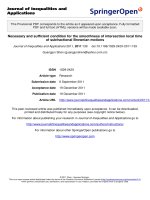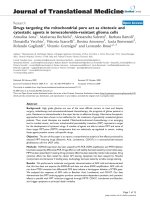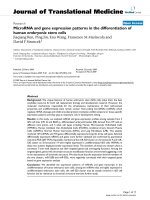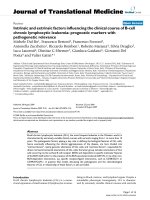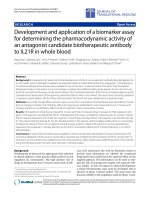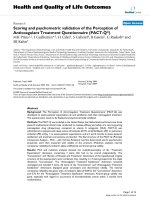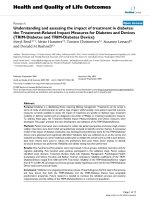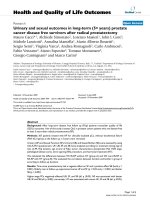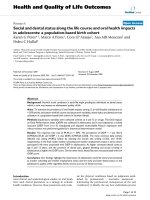báo cáo hóa học:"Personality and the physician-patient relationship as predictors of quality of life of cardiac patients after rehabilitation" pptx
Bạn đang xem bản rút gọn của tài liệu. Xem và tải ngay bản đầy đủ của tài liệu tại đây (291.65 KB, 11 trang )
RESEARC H Open Access
Personality and the physician-patient relationship
as predictors of quality of life of cardiac patients
after rehabilitation
Erik Farin
*
, Milena Meder
Abstract
Background: Numerous studies document the influence of psychosocial variables on the cou rse of coronary heart
disease. This study examines the influence of personality traits (trait anger, cynicism) and aspects of the physician-
patient relationship (promoting patient participation by the physician, active communicati on behavior of the
patient, trust in the physic ian) on the health related quality of life (HRQOL) of cardiac patients after rehabilitation.
Methods: N = 331 patients with chronic ischemic heart disease were surveyed using questionnaires at two time
points (beginning and end of 3-weeks inpatient rehabilitation). In addition, characteristics of the disease and
cardiac risk factors were provided by the physician. HRQOL was measured using a total of six scales and three
instruments: SF-12, MacNew questionnaire, and SAQ. Hierarchical regression analyses were carried out to predict
HRQOL after rehabilitation, in which the baseline values of HRQOL, sociodemographic variables, characteristics of
the disease and risk factors, personality traits, and finally the aspects of the physician-patient relationship were
included stepwise. As a number of variables were used for the regression models, multiple imputation was
conducted.
Results: The baseline values explain most of the variance (42%-60%). After controlling the baseline values, the
sociodemographic variables explain up to 5% incremental variance of HRQOL, with income being the most
important predictor. The characteristics of the disease and cardiac risk factors explain between 0.4% and 3.8%
incremental variance, however, variance increase is often not significant. The personality traits added in the fourth
step explain up to 2% additional variance; trait anger is a significant predictor of HRQOL in three of the six scales.
The features of the physician-patient relationship included in the last step lead to a significant increase in
explained variance (between 1.3% and 3.9%) for all six scales. In particular, the physician’s promotion of patient
participation has a significant influence. The overall explanation of variance for HRQOL is between 50% and 64%.
Conclusions: Low income, a high level of trait anger, and low patient participation are significant risk factors, even
if a number of potential confounders are adjusted. Research is needed that shows which causal pathway low
income functions on and what therapies in rehabilitation can mitigate the disadvantage of persons with a high
level of trait anger. The providers should implement measures to actively integrate rehabilitation patients in
treatment (e.g. encourage them to ask questions).
Introduction
There is extensive empirical evidence that psychological
and psychosocial characteristics have an influence on the
incidence and prognosis of coronary heart disease (CHD)
(e.g. [1,2]). Additionally, the influence of psychosocial
variables on risk factors for CHD such as hypertension,
smoking behavior, serum cholesterol, and body mass
index has been shown [3-6]. Among the p sychological
characteristics most frequently discussed in this context
are the personality characteristics anger and cynicism.
With reference to Spielberger’ sState-TraitAnger
Expression Inventory (STAXI) [7] and the concept of
anger on which this instrument is based, a differentia-
tion is frequently made between trait anger, anger
* Correspondence:
University Medical Center Freiburg, Dept. of Quality Management and Social
Medicine, Breisacher Str. 62/Haus 4 D-79106, Freiburg, Germany
Farin and Meder Health and Quality of Life Outcomes 2010, 8:100
/>© 2010 Farin and Meder; licensee BioMed Central Ltd. This is an Open Access article distributed under the terms of the Creative
Commons Attribution License (http://creative commons.org/licenses/by/2.0), which permits unrestricted use, distribution, a nd
reproduction in any medium, provided the original work is properly cited.
expression, and anger suppression. Trait anger is consid-
ered a personality trait characterized by the fact that the
person perceives many situationsasannoyingandthus
experiences frequent, intense anger [8]. Studies that
have examined the influence of trait anger come to the
conclusion that even after adjusting standard risk factors
such as age, race, body mass index, education, and
smoking, a correlation with carotid artery atherosclerosis
[9,10] or high blood pressure [3] can be proven.
Cynicism can be considered the cognitive component
of the multidimensional construct “ hostility” [11,12].
The construct includes negative beliefs about human
nature and the belief that others are potentially threa-
tening antagonists, who frequently have negative inten-
tions and should thus be met with caution and distrust.
Anger and cynicism are viewed as independent risk fac-
tors for CHD, however, they are related, as anger can
also be considered an affective component of hostility
[11,13]. Studies have shown that cynicism or closely
related concepts such as hostile attributions are predic-
tors of mortality in p atients with CHD [14] and are
associated with a higher probability of the occurrence of
adverse events (e.g. hospitalization for angina, nonfatal
myocardial infarction) [15]. In the normal population as
well, cynicism appears to be associated with an
increased risk of incident myocardial infarction (cf.
[16]), however, there are also studies that find no corre-
lation after adjusting for relevant risk factors [17]. Many
studies examine either anger or cynicism; some (such as
[18]) analyze the influence of both variables in parallel.
When examining the relevance of anger and cynicism,
the primary focus was on mortality, the incidence of
new cardiac diseases, or the occurrence of impaired
body functions. Health-related quality of life (HRQOL)
or other patient-reported outcomes were given less con-
sideration, although improving or maintaining HRQOL
is very important for chronic cardiac patients and - par-
ticularly in the rehabilitation phase - is an important
treatment goal (cf. [19, 20]). Julkunen and Ahlström [21]
foundinalargesampleofpatientswithanincreased
risk of cardiovascular disease that cynicism and anger
correlate with HRQOL. The impact of cynicism and
anger was, to a great extent, mediated through sense of
coherence. A few soci odem ographic variables were con-
sidered as confounding factors, but not body function
parameters or other cardiac risk factors. In a series of
studies [22,23], Shen et al. developed prognosis models
for predicting the HRQOL of cardiac patients following
rehabilitation and they come to the conclusion that hos-
tility affects HRQOL directly and indirectly through
depression. However, in the two studies mentioned,
anger was not taken into consideration.
Since the personality variables anger and cynicism
(especially the latter ) have a direc t effec t on the form of
social interaction, it can be expected that they have a
correlation to the quality of the physician-patient rela-
tionship. However, w e are not aware of any study that
has examined both the influence of these personality
variables and the influence of the physician-patient rela-
tionship on the HRQOL of CHD patients after rehabili-
tation. Of the studies mentioned above, only the studies
by Shen et al. [22,23] study rehabilitation care; the
authors examine patients in outpatient rehabilitation.
While research groups that have dealt with the influ-
ence of anger and cynicism on cardiac disease are
frequently based in behavioral medicine or psychoso-
matic medicine, there are studies on the significance of
physician-patient communication from the field of pro-
vider-patient research. These studies show that aspects
of the physician-patient relationship such as involving
the patient in decision-makin g processes [24,25], posi-
tive assessment of communication and interaction by
the patient [26,27], and patient’s trust in the physician
[28] affect not only adherence, but the patient-reported
outcome of treatment as well.
The objective of our study is to address elements of
these two research traditions in parallel. We examine
two hypotheses:
1. Even after adjusting for relevant sociodemographic
characteristics, characteristics of the CHD (including
risk factors), and the HRQOL at the beginning of inpati-
ent rehabilitation, the personality traits cynicism and
anger correlate with the HRQOL after rehabilitation.
2. Even after adjusting for relevant sociodemographic
characteristics, characteristics of the CHD (including risk
factors), the HRQOL at the beginning of inpatient rehabili-
tation, and the personality traits cyn icism und anger,
aspects of the physicianpatient relationship perceived by
the patient correlate with the HRQOL after rehabilitation.
Through statistical controlling for HRQOL at the begin-
ning of rehabilitation, it is examined whether the personal-
ity traits and the physician-patient relationsh ip allow the
improvements in the HRQOL that can be achieved by
inpatient reha bilitation to be predicted. According to the
findings available in literature on confounding influence
factors for CHD patients (e.g. [29-33]) age, gender, living
with a partner, education, employment, and income will
be regarded as sociodemographic confounders. The
existence of an acute event and if applicable, the kind of
surgery performed before rehabilitation (PTCA, bypass)
are important characteristics of the CHD. In addition,
various body functi on parameters and risk factors will be
controlled (body mass index (BMI) , smoker, total choles-
terol, LDL cholesterol, systolic blood pressure, diastolic
blood pressure, and the risk score described by Daly [34]).
Patient participation in the sense of shared decision mak-
ing (SDM) [35] and trust in the physici an are consider ed
aspects of the physician-patient relationship.
Farin and Meder Health and Quality of Life Outcomes 2010, 8:100
/>Page 2 of 11
Methods
Sample
The study has been approved by the ethics committee of
theUniversityFreiburg(approvalnumber63/08).
Patients with chronic ischemic heart disease who were
undergoing inpatient rehabilitation were surveyed. In
Germany, inpatient cardiac rehabilitation aims at achiev-
ing the best possible regeneration of the patient’s cardiac
capacities with respect to all psychosocial aspects in
order to re-integrate the patient into social and working
life [36]. The goals of inpatient rehabilitation are similar
to those of outpatient rehabilitation, but patients in inpa-
tient rehabilit ation are likely to be older, less mobile, and
less often emp loyed [36]. Cardiac reh abilitation is a mul-
tidisciplinary activity. Besid es physicians, the rehabilita-
tion team includes psychologists, nursing staff, exercise
therapists, physiotherapists, nutrionists and social work-
ers. The patient generally has 4-5 therapy sessions a day
on workdays. Rounds and consultations with the physi-
cian take place at least once a week, with add itional con-
sultations by appointment. Normally, there is a physician
responsible for the patient wh o sees him frequently dur-
ing the hospitalization period. Depending on the situa-
tion and extent of medical care required, the patient ma y
have contact with other physicians.
The patient questionnaires were given only to patients
who were able and willing to fill out the questionnaires
(informed consent). N = 742 patients were asked to par-
ticipate, N = 331 agreed. The percentage of patients that
did not fill out the questionnaire (decliners) was 55.4%.
Themostimportantreasonfornon-inclusionwasrefu-
sal to participate (46.4%), followed by cognitive or physi-
cal limitations (13.0%) and language problems (6.5%).
For 34.2% of the patients no reason for noninclusio n
was reported. Table 1 provides information on the
patients in the study.
Instruments
At the beginning and end of the inpatient rehabilitation
lasting an average of 21 (+/-3.1) days, the patients were
asked to fill out a questionnaire that, in addition to socio-
demographic information, included the SF-12 [37] (scales:
physical component PC and mental component MC),
MacNew [38] (scales: physical limitation PL, emotional
functioning EF, social functioning SF), Seattle Angina
Questionnaire SAQ [39] (scale considered here: physical
limitation PL), Perceived Involvement in Care Scales PICS
[40] (scales: doctor facilitation DF, patient information PI),
Trust in Physician [41], MMPI-2 scale cynic ism [42], and
STAXI scale trait anger [7]. Several instruments for quality
of life were implemented in parallel to enable statements
about the method-related variance. The rehabilitation phy-
sicians filled out a documentation sheet at the beginning
and end of rehabilitation that covered mainly characteris-
tics of the disease and cardiac risk factors.
For the study reported here, the respective German
language versions were used, which are available for all
instruments and whose psychometric quality criteria
have already been tested in various studies and were
found to be satisfactory to good overall (cf. e.g. [43,44]
for the HRQOL instruments).
Analyses
Multiple imputation
Since we conduct regression analyses with a large num-
ber of predictors that all have a certain percentage of
mis sing values, a meth od using casewise deletion would
have many disadvantages (cf. [45]). Therefore, multiple
imputation [46] was used. First, all persons with more
than 50% missing values (cf. [45]) were eliminated from
the data set. This reduced the data set to N = 319 cases.
Then five imputed data sets were created using NORM
software [47] according to the recommendations of
Rubin [46]. An expectation-maximizati on algorithm and
Table 1 Respondent characteristics
Average age (SD) 61.1 (10.9)
Gender
% of men 82.4
Level of education (highest level Completed)
% elementary school 52.6
Employment
% employed 41.0
Monthly household income (%)
< 500 Euro 4.0
500 -1.000 Euro 10.0
1.000 - 1.500 Euro 23.3
1.500 - 2.000 Euro 24.1
2.000 - 2.500 Euro 19.3
2.500 - 3.000 Euro 7.2
3.000 - 3.500 Euro 5.2
> 3.500 Euro 6.8
Acute event/surgery
% Myocardial infarction 65.7
% PTCA 62.3
% Bypass
(Multiple choices possible)
34.7
Chronification (%)
Acute event 45.7
< 1 year 29.0
1-2 years 6.1
3-5 years 6.5
6-10 years 4.1
> 10 years 7.2
Farin and Meder Health and Quality of Life Outcomes 2010, 8:100
/>Page 3 of 11
the data augmentation procedure integrated in the
NORM software were applied. We examine the conver-
gence behavior with NORM’s plotting procedure. The
plots show rapidy coverging series and low autocorrela-
tion. The analyses presented in the results section were
carried out with all five imputed data sets. The relevant
parameters (regression coefficients, standard errors, etc.)
were combined according to the rules presented by
Rubin [46].
Regression analyses
Hierarchical regression analyses were performed, in
which first the baseline values with respect to the
respective dependent variables (HRQOL scales) were
included. In the second block, all confounding sociode-
mog raphic variables that were listed in the introduction
were added, in the third step characteristics of the
CHD, body function parameters, and risk factors, and in
the fourth block, the personality variables (cynicism and
anger). Finally, in the fifth step, the characteristics of
physician-patient relationship perceived by the patient
were included. A stepwise method of variable inclusion
(PIN = .05 POUT = .10) was employed. The predictors
that were included in the model in at least two of the
five imputed data sets were considered as potentially
relevant predictors. With this restriction, more sparse
models could be specified and problems of multicolli-
nearity avoided. A separate model was specified for each
of the six dependent variables (two SF-12 scales, three
MacNew scales, one SAQ scale). Finally, the regression
models that consisted only of potentially relevant
predictors were again applied to all five imputed sets.
Here again, hierarchical regression analyses were com-
puted, but now using the forced entry method of vari-
able inclusion, making the results in the five imputed
data sets directly comparable. For the diagnosis of
multicollinearity, the variance inflation factor (VIF) was
calculated. Values over 5 can be considered as an indi-
cation of multicollinearity [48]. Statistical analyses were
performed using SPSS 17.0 [49].
Results
Table 2 shows descriptive statistics for the HRQOL
scales, the personality variables and the characteristics
of physician-patient relatio nship. For the HRQOL scales,
the table also shows the effect sizes of the change after
rehabilitation (difference of the mean values divided by
the pretest standard deviation); the values are .22 to .57,
in the range of low to moderate effects (cf. [50]).
Before addressing the results of the multivariat e ana-
lyses, the bivariate correlations between the dependent
variables analyzed and all the respective potentially rele-
vant predictors are shown in Table 3. It can be seen that
the baseline value always had the greatest correlation
with the HRQOL value after inpatient rehabilitation. For
the sociodemographic variables, income had the greatest
correlation with HRQOL after rehabilitation and for
medical variables, the risk score. Both the personality
variables and the aspects of the physician-patient
relationship correlate significantly with the HRQOL on
various scales.
Table 4 presents the results of the hierar chical regres-
sion analyses. The values of the VIF are generally below
2 and always below 5, so there is no indication of high
multicollinearity. The baseline values explain between
42.0% and 59.4% of the variance of the HRQOL valu es
after rehabilitation. The sociodemographic variables
show significant incremental explanation of variance on
all HRQOL scales. The additional explained variance
ranges between 0.7% and 5.0%. The most significant
sociodemographic variable is - just as for the univariate
analyses - income, and th e influence of income on emo-
tional and mental aspects of the HRQOL is even clearer.
Even taking all confounders mentioned here into
consideratio n, persons with higher incomes also indicate
a higher psychological HRQOL at follow-up; i.e., they
appear to benefit more from rehabilitation.
The characteristics of the CHD and the risk factors
explain only little incremental variance beyond the
sociodemographic variables. The amount ranges
between 0.4% and 3.8% and is often not significantly dif-
ferent from zero. The most important predictor variable
within this block of variables is the cardiac risk score,
which is particularly signi ficant with respect to the
physical component of HRQOL. Persons with a higher
risk score, that is with a higher probability for death or
myocardial infarction, have a lower HRQOL after reha-
bilitation, i.e. they benefit less from rehabilitation with
respect to HRQOL.
On all three psychosocial scales and on the “physical
limitation” scale of the MacNew que stionnaire, the two
personality variables trait anger and cynicism together
explain a significant portion of incremental variance,
which is albeit not too high (between 0% and 2.0%). For
the psychosocial HRQOL, trait anger appears to be
more important than cynicism. Persons w ho tend to be
angry in many situations have a lower HRQOL after
rehabilitation, even after adjusting for sociodemographic
variables, characteristics of the CHD, and risk factors.
Cynicism also proves to be a relevant risk factor for one
of the HRQOL constructs - the physical limitation mea-
sured by the SAQ is less favorable if the person exhibits
negative and cynical attitudes.
In the last step, after the baseline HRQOL values and
after sociodemographic, medical, and personality vari-
ables, aspects of the physician-patient relationship per-
ceived by the patient were included in the regression
model. Although there were thus strict conditions for
achieving additi onal explanation of variance, the aspects
Farin and Meder Health and Quality of Life Outcomes 2010, 8:100
/>Page 4 of 11
led to a significant increase in explained variance for all
six HRQOL scales. The amount fluctuated between
1.3% and 2.9% and is thus generally greater than the
increase in explanation of variance by the characteristics
of the disease. The relevance of this block of variables is
mainly due to the doctor facilitation scale of the PICS:
patients who experienced the physician as a provider
who attempted to include the patient in the treatment
(e.g. asked the patient for consent; asked the patient
what he considered to be the causes of his condition;
encouraged the patient to give his opinion), had a higher
quality of life at the end of rehabilitation than patients
who experienced a patriarchal style of interaction. Trust
in the physician was only occasionally a significant pre-
dictor in the multivariate analyses; the patient’ sactive
communication behavior (patient information scale of
the PICS) does not appear to be relevant.
Discussion
The two hypotheses presented in the introduction were
confi rmed, at least for some of the sub -dimensions. The
relevance of the personality variables was shown in par-
ticular for the psychosocial aspects of the HRQOL,
while the aspects of the physician-patient relationship
are important for all domains of the HRQOL. The con-
firmation of the significance of anger and cynicism is
compatible with existing studies [21-23], and it should
be mentioned as a strength of our study that a number
of disease characteristics and body function parameters
were controlled and that the HRQOL was measured
using various instruments. It was seen that the disease
characteristics are generally less significant, with the
exception of the risk score as a measure of the severity
of the illness. While the differences between the various
HRQOL scales are considerable for individual predic-
tors, the fundamental relevance of the personality vari-
ables and the physician-patient relatio nship was seen to
be independent of whether the SF-12, the MacNew
questionnaire, or the SAQ was used.
Our data also show the relevance of income for the
improvement of the psychological quality of life. After
thebaselinevalue,incomewasthemostimportant
Table 2 Descriptive statistics
Minimum in dataset Maximum in dataset Mean Standard deviation Effect size (for HRQOL scales)
HRQOL
SF-12: PC
Start of rehabilitation 8,47 58,51 34,09 10,29 .32
End of rehabilitation 7,51 65,11 37,34 10,87
MacNew: PL
Start of rehabilitation 1.60 7 4.69 1.22 .46
End of rehabilitation 1,99 7 5,25 1,10
SAQ: PL
Start of rehabilitation 0 100 56,35 25,29 .22
End of rehabilitation 0 100 61,85 24,78
SF-12: MC
Start of rehabilitation 9,84 70,14 46,39 12,18 .39
End of rehabilitation 11,81 75,37 51,09 11,60
MacNew: EF
Start of rehabilitation 1,17 7 4,79 1,24 .47
End of rehabilitation 1,33 7 5,37 1,13
MacNew: SF
Start of rehabilitation 1,18 7 4,56 1,33 .57
End of rehabilitation 1,80 7 5,32 1,14
Personality variables
Cynicism 0 23 12,63 5,17
Trait anger 10 37 18,24 5,01
Physician patient relationship
PICS: DF 1 4 2,94 0,72
PICS: PI 1 4 3,01 0,75
Trust in physician 25,90 100 79,58 14,44
Personality variables were measured at the beginning of rehabilitation, variables of the physician-patient relationship at the end of rehabilitation. For all HRQOL
scales, higher values indicate higher quality of life. Effect size = difference of the mean values divided by the pretest standard deviation.
Farin and Meder Health and Quality of Life Outcomes 2010, 8:100
/>Page 5 of 11
predictor variable for the SF-12-MC as well as the
MacNew-EF. Literature reports on socioeconomic status
(SES) as a moderator of the correlation between anger
and subclinical atherosclerosis for members of the gen-
eral population (cf. [11]) and occasionally income is also
adjusted (cf. [4]), but we are not aware of any study th at
has examined personality variables and SES in parallel
for the prediction of the HRQOL after cardiac rehabili-
tation. Studies that examine influence factors of the out-
come of cardiac rehabilitation independently of
personality variables occasionally also indicate the influ-
ence of the SES (e.g. [30]), however, there was not
always a clear distinction made b etween education and
income (cf. [31]). Our data indicate that low income
and low education level are separate risk factors,
whereas only income is an influence factor of the psy-
chological HRQOL. Corresponding with this finding, in
our sample there is only a slight correlation between the
two variables (r = 0.28). The significance of SES for the
HRQOL in the context of cardiac rehabilitation is not
surprising, although there has thus far been little proof,
as social inequality in cardiovascular diseases has been
studied on several occasions and correlations have been
found, for example with heart disease mortality [51].
In the analysis of the influence of the physician-
patient relationship on the HRQOL, the physician’ s
inclusion of the patient in treatment planning proved to
be a significant conducive factor for the physical and
social HRQOL. This finding made in a prospective
study does not reach the level of evidence of a rando-
mized controlled trial, but since an extensive control of
potential confounders was m ade and patient participa-
tion was not included until the last block of the model,
it does appear to us to be an argument for the impor-
tance of patient-oriented communication style and for
the relevance of the SDM concept. The results are com-
patible with intervention studies (e.g. [52,53]) and obser-
vation studies [54], which show that for cardiac disease,
Table 3 Bivariate correlations between dependent variables and respective predictors
SF-12:
PC
MacNew:
PL
SAQ: PL SF-12:
MC
MacNew:
EF
MacNew:
SF
Respective base-line value (at start of rehabilitation) .661*** .700*** .707*** .649*** .772*** .700***
Age 220*** - - .087 .146* -
Gender: man .179* - - .188** .095 -
Living with a Partner -
Education: Elementary School 131 095 - - 051 048
Employment - - .274*** - - -
Income - .273*** - .243*** .222*** .198**
Acute event -
Myocardial Infarction -
PTCA .291*** - - - - -
Bypass - - 360*** .016 - -
BMI - - - 021 - -
Smoker .087 - - - - -
Risk score 116 216*** 219*** - - 198**
Total cholesterol - - .080 - 044 -
LDL cholesterol - - .115* - - -
Systolic blood Pressure - - - 025 - -
Diastolic blood Pressure -
Cynicism - 212** 186** - - -
Trait anger - 231*** - 325*** 377*** 277***
PICS: DF .084 .162** .109 .080 .151** .103
PICS: PI 013 .013 - 085 - 030
Trust in Physician - - - .208* .290*** .197***
Pearson correlations with significance level, *** p < .001, ** p < .01, * p < .05, - = not in the model
Farin and Meder Health and Quality of Life Outcomes 2010, 8:100
/>Page 6 of 11
Table 4 Hierarchical regression analyses to predict HRQOL at the end of rehabilitation
SF-12: PC MacNew: PL SAQ: PL SF-12: MC MacNew: EF MacNew: SF
Block 1
Respective baseline value (at start of
rehabilitation)
.631 (p < .001) .613 (p < .001) .605 (p < .001) .582 (p < .001) .723 (p < .001) .633 (p < .001)
R
2
change =
.436***
R
2
change =
.488***
R
2
change =
.498***
R
2
change =
.420***
R
2
change =
.594***
R
2
change =
.488***
Block 2
Age 112 (p = .050) - - .090 (p = .105) .087 (p = .049) -
Gender: man .083 (p = .105) - - .079 (p = .083) 084 (p = .029) -
Living with a partner
Education: elementary school 151 (p = .002) 057 (p = .214) - - 034 (p = .436) 058 (p = .226)
Employment - - .070 (p = .113) - - -
Income - .082 (p = .149) - .151 (p = .013) .119 (p = .004) .088 (p = .106)
R
2
change =
.050***
R
2
change =
.011*
R
2
change =
.007*
R
2
change =
.037*
R
2
change =
.023**
R
2
change =
.013*
Block 3
Acute event
Myocardial infarction
PTCA .139 (p = .042)
Bypass - - 139 (p = .003) .049 (p = .347) - -
BMI - - - .074 (p = .133) - -
Smoker 082 (p = .280)
Risk score 055 (p = .350) 113 (p = .017) 123 (p = .016) - - 103 (p = .067)
Total cholesterol - - .114 (p = .392) - .074 (p = .044) -
LDL cholesterol - - .028 (p = .746) - - -
Systolic blood pressure - - - .067 (p = .369) - -
Diastolic blood pressure
R
2
change =
.024**
R
2
change =
.004
R
2
change =
.038**
R
2
change =
.010
R
2
change =
.005*
R
2
change =
.005
Block 4
Cynicism - 077 (p = .219) 108 (p = .033) - - -
Trait anger - 095 (p = .028) - 118 (p = .091) 080 (p = .032) 144 (p < .001)
R
2
change =
.000
R
2
change =
.015**
R
2
change =
.006
R
2
change =
.013**
R
2
change =
.006**
R
2
change =
.020***
SF-12: PC MacNew: PL SAQ: PL SF-12: MC MacNew: EF Mac New:SF
Block 5
PICS: DF .130 (p = .049) .220 (p = <
.001)
.130 (p = .004) .099 (p = .357) .069 (p = .148) .132 (p = .025
PICS: PI 127 (p = .187) 089 (p = .276) 123 (p = .076) - 101 (p = 183
Trust in physician - - - .095 (p = .086) .087 (p = .046) .052 (p = .384)
R
2
change =
.013*
R
2
change =
.029***
R
2
change =
.015**
R
2
change =
.022**
R
2
change =
.017**
R
2
Change =
.016**
R
2
.523 .547 .563 .503 .645 .542
Standardized regression coefficients and R
2
change with significance, *** p < .001, ** p < .01, * p < .05, - = not in the model. Significant parameters (p < .05) are
printed in bold type.
Farin and Meder Health and Quality of Life Outcomes 2010, 8:100
/>Page 7 of 11
including the patient in the decision-making process
leads to a positive effect on the treatment outcome.
However, on the basis of our data we cannot make any
statements about the causal pa th that ultimately leads
from the physician’s interaction style to an improvement
in the HRQOL. A mediator function o f therapy adher-
ence is conceivable [55].
It was surprising that active patient communication
aimed at participation (e.g. asking physicians to explain
treatment in more detail; asking physicians about symp-
toms of the illness) did not have a significant influence
on any HRQOL scale. This was in contrast to studies
that show that patient participation can be improved
with comparably easy-to-conduct patient communica-
tion trainings (cf. [56,57]). It is possible that, without
intervention, the influence of proactive patient behavior
is too weak to influence the treatment process and thus
the HRQOL at the end of treatment. The only slight
significance of trust in t he physician leads to the
assumption that the decisive factor influencing the phy-
sician-patient relationship for the cardiac patients stu-
died here is not so much the quality of the emotional
relationship as it is the physician’s function in activating
the patient and emphasizing his own responsibility. The
assumption that the meager influence of trust in the
physician is based on ceiling effects that are known
from patient satisfaction research [58] was not con-
firmed; the Trust-in-Physician questionnaire has good
distribution properties (data not presented in the results
section).
The relevance of income for HRQOL presented above
underlines the usefulness of the multiple imputation
method chosen here. Since a relatively large number of
missing values can be anticipated for data on income
(cf. [59]; in our dataset, the percentage of missing values
was 24.8%) and a selective loss of data can be expected
[60], a meaningful analysis of the relevan ce of income is
difficult to achieve without an elaborated imputation
method.
Our study has many limitations that should be
addressed in closing. The relatively high decliner rate
means that the patients studied cannot be considered
representative for all inpatient rehabilitation patients
with CHD. Since the most important reason for exclu-
sion was refusal to participate, it is difficult to estimate
what influence the high decliner rate has on the results
reported here. In a comparable study [61], it was found
that decliners are sicker and achieve less improvement
after rehabilitation. This would presumably mean that in
the group of non-participants, if the number of c ases
werethesame,itwouldbemoredifficulttoprovethe
relevance of the predictors studied here.
We studied two personality traits important for CHD
patients in parallel, but there are other psychological
constructs (e.g. depression [62,23] and sense of coher-
ence [21]), that are closely related to anger und cynicism
and possibly function as mediators or moderators.
Frasure-Smith and Lésperance [63] emphasize that nega-
tive emotions (such as anger or depression) are likely to
be correlated with an underlying dimension reflecting a
general tendency to experience or report negative emo-
tions, which can possibly be described as neuroticism.
This means that we cannot be certain that the correla-
tion with HRQOL found for anger and cynicism are
actually only the result of these specific constructs or
are perhaps also an expression of a general emotional
state. If we had included other psychological variables,
an approach using structural equation models to repre-
sent individual causal paths between the relevant
constructs would have been promising.
It can also not be ruled out that there are other rele-
vant predictors of HRQOL after rehabilitation that we
did not cover (for example treatment motivation). It is
also conceivable that activity limitations of patients at
the start of rehabilitation have an influence and we can
present them only to a limited extent with the medical
variables and the HRQOL baseline values considered
here.
With respect to anger, it should also be stressed that
we studied only trait anger as a personality variab le, not
mod es of anger expression (anger-in, anger-out, cf. [9]),
which are considered aspects of affect regulation. How-
ever, this decision appears useful to us, as the patient in
the rehabilitation hospital is in a special setting, so
results regarding state variables are difficult to
generalize.
Inclusion of the patient in the sense of SDM was mea-
sured only in relatively generally terms with the PICS
scale. Newer conceptual studies (e.g. [64,65]) empha size
that the SDM construct has many factors depending on
the definition; they can be only partially measured with
the PICS. In addition, the PICS measures only patient
perception, not the physician’s assessment.
One limitation of the method is that in our analyses, we
could not represent the multilevel structure of the data
that stems from the fact that several patients were treated
by the same physicians, as the allocation of patient to
physician was not documented when the data was gath-
ered. This aspect is relevant for the variables of the physi-
cian-patient re lationship. The patient’ s assessments are
not independent of one another for persons who have
the same physician; as a result, the standard error for the
linear regression is too small and correlations can be
overestimated [66]. The problem is somewhat mitigated
by the fact that we did not measure the objectively obser-
vable behavior of the physician, but rather the behavior
assessed retrospectively by the patient. Th is judgment
depends not only on the physician’s behavior, but also on
Farin and Meder Health and Quality of Life Outcomes 2010, 8:100
/>Page 8 of 11
the cognitive system of the patient. The dependence of
the judgments related to one and the same physician is
thus reduced.
Finally,itshouldbepointedoutthatweusedonly
questionnaires to measure the physician-patient rela-
tionship and not observational procedures or oth er qua-
litative methods. This leads to the problem of the
common method bias (cf. e.g. [67]). Correlations
between the influence factors observed here and the
HRQOL could be overestimated because we used the
same method to measure them. However, Doty and
Glick [68] showed on the basis of published multitrait-
multimethod c orrelation matrices that the common
method bias is rarely high enough to cast a doubt on
the central results of research.
Conclusions
The baseline values explain most of the variance of
HRQOL after inpatient cardiac rehabilitation. HRQOL
depend also on income, personality traits (especially
anger), and patient-participation in treatment. These
variables cover a relevant portion of the explainable var-
iance of the HRQOL in o ur study. The study thus con-
firms findings that are reported in the existing literature
mainly for the health care outcomes mortality and body
function parameters. Treatment concepts in rehabilita-
tion should include strategies that ensure the success of
the intervention even for risk patients (high degree of
experienced anger, low income). For providers, an inter-
action style is recommended that actively includes the
patient in the rehabilitation and thus promotes self-
management in dealing with the chronic illness.
Abbreviations
BMI: body mass index; CHD: coronary heart disease; HRQOL: health-related
quality of life; PICS: Perceived Involvement in Care Scales; PTCA:
percutaneous transluminal coronary angioplasty; SAQ: Seattle Angina
Questionnaire; SDM: shared decison making; SES: socioeconomic status;
STAXI: State-Trait Anger Expression Inventory.
Acknowledgements
The project from which the data reported here stem ("Patient-oriented
outcome measurement: Health valuation and assessment of the relevance of
the changes in patients’ participation”) was supported by the German
Federal Ministry for Education and Research as part of the funding program
“Chronic Illnesses and Patient Orientation”.
We thank the participating rehabilitation centers and their staff: AHG Klinik
Wolletzsee (Wolletz), Drei-Burgen-Klinik (Bad Münster am Stein - Ebernburg),
Gesundheitszentrum Oberammergau (Oberammergau), Kerckhoff-
Rehabilitations-Zentrum (Bad Nauheim), Klinik am Südpark (Bad Nauheim),
Klinik Bad Wörishofen (Bad Wörishofen), Median Kliniken am Burggraben
(Bad Salzuflen).
Authors’ contributions
EF analyzed the data and prepared the manuscript. MM assisted in the
analysis of the data. Both authors contributed to the conception and design
of the study. Both authors read and approved the final manuscript.
Competing interests
The authors declare that they have no competing interests.
Received: 15 December 2009 Accepted: 14 September 2010
Published: 14 September 2010
References
1. Rozanski A, Blumenthal JA, Kaplan J: Impact of psychological factors on
the pathogenesis of cardiovascular disease and implications for therapy.
Circulation 1999, 99:2192-2217.
2. Smith TW, Glazer K, Ruiz JM, Gallo LC: Hostility, anger, aggressiveness, and
coronary heart disease: An interpersonal perspective on personality,
emotion, and health. J Pers 2004, 72:1217-1270.
3. Schum JL, Jorgensen RS, Verhaeghen P, Sauro M, Thibodeau R: Trait anger,
anger expression, and ambulatory blood pressure: a meta-analytic
review. J Behav Med 2003, 26(5):395-415.
4. Rutledge T, Reis SE, Olson M, Owens J, Kelsey SF, Pepine CJ, Reichek N,
Rogers WJ, Merz CN, Sopko G, Cornell CE, Matthews KA: Psychosocial
variables are associated with atherosclerosis risk factors among women
with chest pain: the WISE study. Psychosom Med 2001, 63(2):282-8.
5. Markovitz JH, Jonas BS, Davidson K: Psychologic factors as precursors to
hypertension. Curr Hypertens Rep 2001, 3(1):25-32.
6. Goldbacher EM, Matthews KA: Are psychological characteristics related to
risk of the metabolic syndrome? A review of the literature. Ann Behav
Med 2007, 34(3):240-52.
7. Spielberger CD: State-Trait Anger Expression Inventory Odessa, FL:
Psychological Assessment Resource Inc 1999.
8. Kassinove H: Anger disorders: Definition, diagnosis, and treatment
Washington, DC: Taylor & Francis 1995.
9. Bleil ME, McCaffery JM, Muldoon MF, Sutton-Tyrrell K, Manuck SB: Anger-
related personality traits and carotid artery atherosclerosis in untreated
hypertensive men. Psychosom Med 2004, 66(5):633-9.
10. Narita K, Murata T, Takahashi T, Hamada T, Kosaka H, Yoshida H, Wada Y:
The association between anger-related personality trait and cardiac
autonomic response abnormalities in elderly subjects. Eur Arch Psychiatry
Clin Neurosci 2007, 257(6):325-9.
11. Merjonen P, Pulkki-Raback L, Puttonen S, Keskivaara P, Juonala M, Telama R,
Viikari J, Raitakari OT, Keltikangas-Jarvinen L: Anger is associated with
subclinical atherosclerosis in low SES but not in higher SES men and
women. The Cardiovascular Risk in Young Finns Study. J Behav Med
2008, 31:35-44.
12. Holt-Lunstad J, Smith TW, Uchino BN: Can hostility interfere with the
health benefits of giving and receiving social support? The impact of
cynical hostility on cardiovascular reactivity during social support
interactions among friends. Ann Behav Med 2008, 35(3):319-30.
13. Ravaja N, Kauppinen T, Keltikangas-Jarvinen L: Relationships between
hostility and physiological coronary heart disease risk factors in young
adults: the moderating influence of depressive tendencies. Psychol Med
2000, 30(2):381-93.
14. Boyle SH, Williams RB, Mark DB, Brummett BH, Siegler IC, Helms MJ,
Barefoot JC: Hostility as a predictor of survival in patients with coronary
artery disease. Psychosom Med 2004, 66:629-632.
15. Olson MB, Krantz DS, Kelsey SF, Pepine CJ, Sopko G, Handberg E,
Rogers WJ, Gierach GL, McClure CK, Merz CN, WISE Study Group: Hostility
scores are associated with increased risk of cardiovascular events in
women undergoing coronary angiography: a report from the NHLBI-
Sponsored WISE Study. Psychosom Med 2005, 76:546-552.
16. Everson SA, Kauhanen J, Kaplan GA, Goldberg DE, Julkunen J, Tuomilehto J,
Salonen JT: Hostility and increased risk of mortality and acute myocardial
infarction: The mediating role of behavioral risk factors. Am J Epidemiol
1997, 146:142-152.
17. Siegman AW, Townsend ST, Blumenthal RS, Sorkin JD, Civelek AC:
Dimensions of anger and CHD in men and women: self-ratings versus
spouse ratings. J Behav Med 1998, 21(4):315-36.
18. Krantz DS, Olson MB, Francis JL, Phankao C, Bairey Merz CN, Sopko G,
Vido DA, Shaw LJ, Sheps DS, Pepine CJ, Matthews KA: Anger, hostility, and
cardiac symptoms in women with suspected coronary artery disease:
the Women’s Ischemia Syndrome Evaluation (WISE) Study. J Womens
Health 2006, 15(10):1214-23.
19. Shephard RJ, Franklin B: Changes in the quality of life: a major goal of
cardiac rehabilitation. J Cardiopulm Rehabil 2001, 21(4):189-200.
20. Oldridge N: Assessing health-related quality of life: is it important when
evaluating the effectiveness of cardiac rehabilitation? J Cardiopulm
Rehabil 2003, 23(1):26-8.
Farin and Meder Health and Quality of Life Outcomes 2010, 8:100
/>Page 9 of 11
21. Julkunen J, Ahlstrom R: Hostility, anger, and sense of coherence as
predictors of health-related quality of life. Results of an ASCOT
substudy. J Psychosom Res 2006, 61(1):33-9.
22. Shen BJ, Myers HF, McCreary CP: Psychosocial predictors of cardiac
rehabilitation quality-of-life outcomes. J Psychosom Res 2006, 60(1):3-11.
23. Shen BJ, McCreary CP, Myers HF: Independent and mediated
contributions of personality, coping, social support, and depressive
symptoms to physical functioning outcome among patients in cardiac
rehabilitation. J Behav Med 2004, 27(1):39-62.
24. Joosten EA, Fuentes-Merillas L, de Weert GH, Sensky T, van der Staak CP, de
Jong CA: Systematic review of the effects of shared decision-making on
patient satisfaction, treatment adherence and health status. Psychother
Psychosom 2008, 77(4):219-26.
25. O’Connor AM, Bennett CL, Stacey D, Barry M, Col NF, Eden KB, Entwistle VA,
Fiset V, Holmes-Rovner M, Khangura S, Llewellyn-Thomas H, Rovner D:
Decision aids for people facing health treatment or screening decisions.
Cochrane Database of Syst Rev 2009, 3.
26. Zachariae R, Pedersen CG, Jensen AB, Ehrnrooth E, Rossen PB, von der
Maase H: Association of perceived physician communication style with
patient satisfaction, distress, cancer-related self-efficacy, and perceived
control over the disease. Br J Cancer 2003, 88:658-665.
27. Stewart M, Brown JB, Donner A, McWhinney IR, Oates J, Weston WW,
Jordan J: The impact of patient-centered care on outcomes. J Fam Pract
2000, 49:796-804.
28. Lee YY, Lin JL: The effects of trust in physician on self-efficacy,
adherence and diabetes outcomes. Soc Sci Med 2009, 68:1060-1068.
29. Le Grande MR, Elliot PC, Murphy BM, Worcester MUC, Higgins RO,
Ernest CS, Goble AJ: Health related quality of life trajectories and
predictors following coronary artery bypass surgery. Health Qual Life
Outcomes 2006, 4.
30. Müller-Nordhorn J, Kulig M, Binting S, Völler H, Gohlke H, Linde K,
Willich SN: Change in quality of life in the year following cardiac
rehabilitation. Qual Life Res 2004, 13:399-410.
31. Veenstra M, Pettersen KI, Rollag A, Stavem K: Association of changes in
health-related quality of life in coronary heart disease with coronary
procedures and sociodemographic characteristics. Health Qual Life
Outcome 2004, 2:56.
32. Oldridge N, Gottlieb M, Guyatt G, Jones N, Streiner D, Feeny D: Predictors
of healthrelated quality of life with cardiac rehabilitation after acute
myocardial infarction. J Cardiopulm Rehabil 1998, 18:95-103.
33. van Eck JW, van Hemel NM, van den BA, Taks W, Grobbee DE, Moons KG:
Predictors of improved quality of life 1 year after pacemaker
implantation. Am Heart J 2008, 156(3):491-7.
34. Daly CA, De Stavola B, Sendon JLL, Tavazzi L, Boersma E, Clemens F,
Danchin N, Delahaye F, Gitt A, Julian D, Mulcahy D, Ruzyllo W, Thygesen K,
Verheugt F, Fox KM, on behalf of the Euro Heart Survey Investigators:
Predicting prognosis in stable angina–results from the Euro heart survey
of stable angina: prospective observational study. BMJ 2006,
332:262-267.
35. Makoul G, Clayman ML: An integrative model of shared decision making
in medical encounters. Patient Educ Couns 2006, 60:301-312.
36. Karoff M, Held K, Bjarnason-Wehrens B: Cardiac rehabilitation in Germany.
Eur J Cardiovasc Prev Rehabil 2007, 14:18-27.
37. Ware JE, Kosinski M, Keller SD: A 12-item short-form health survey:
construction of scales and preliminary tests of reliability and validity.
Med Care 1996, 34:220-233.
38. Höfer S, Lim LLY, Guyatt G, Oldridge N: The MacNew Heart Disesease
health-related quality of life instrument: A summary. Health Qual Life
Outcome 2004, 2:3.
39. Spertus JA, Winder JA, Dewhurst TA, Deyo RA, Prodzinski J, McDonell M,
Fihn SD: Development and evaluation of the Seattle Angina
Questionnaire: a new functional status measure for coronary artery
disease. J Am Coll Cardiol 1995, 25:333-341.
40. Lerman CE, Brody DS, Caputo GC, Smith DG, Lazaro CG, Wolfson HG:
Patients’ Perceived Involvement in Care Scale: Relationship to attitudes
about illness and medical care. J Gen Intern Med 1990, 5:29-33.
41. Anderson LA, Dedrick RF: Development of the trust in physician scale: a
measure to assess interpersonal trust in patient-physician relationships.
Psychol Rep 1990, 67:1091-1100.
42. Graham JR: MMPI-2: Assessing personality and psychopathology New York,
NY: Oxford University Press 2000.
43. Maurischat C, Morfeld M, Kohlmann T, Bullinger M: Lebensqualität:
Nützlichkeit und Psychometrie des Health Survey SF-36/SF-12 in der
medizinischen Rehabilitation Lengerich: Pabst 2004.
44. Höfer S, Benzer W, Schüßler G, von Steinbüchel N, Oldridge N: Health-
related quality of life in patients with coronary artery disease treated for
angina: Validity and reliability of German translations of two specific
questionnaires. Qual Life Res 2003, 12:199-212.
45. Graham JW: Missing data analysis: Making it work in the real world. Annu
Rev Psychol 2009, 60:549-576.
46. Rubin DB: Multiple imputation for nonresponse in surveys New York: Wiley
1987.
47. Schafer JL: NORM: Multiple imputation of incomplete multivariate data under
a normal model, version 2.03, software for Windows 95/98/NT 1999 [http://
www.stat.psu.edu/~jls/misoftwa.html].
48. Menard SW: Applied logistic regression analysis Thousand Oaks, CA: Sage
2002.
49. PASW Statistics - SPSS 17 Chicago, IL: SPSS, Inc 2008.
50. Cohen J: Statistical power analysis for the behavioral sciences New York:
Academic Press, 2 1988.
51. Cooper RS: Social inequality, ethnicity and cardiovascular disease. Int J
Epidemiol 2001,
30(Suppl 1):S48-52.
52. Morgan MW, Deber RB, Llewellyn-Thomas HA, Gladstone P, Cusimano RJ,
O’Rourke K, Tomlinson G, Detsky AS: Randomized, controlled trial of an
interactive videodisc decision aid for patients with ischemic heart
disease. J Gen Intern Med 2000, 15(10):685-93.
53. Montgomery AA, Fahey T, Peters TJ: A factorial randomised controlled
trial of decision analysis and an information video plus leaflet for newly
diagnosed hypertensive patients. Br J Gen Pract 2003, 53(491):446-53.
54. Naik AD, Kallen MA, Walker A, Street RL Jr: Improving hypertension control
in diabetes mellitus - The effects of collaborative and proactive health
communication. Health Serv Res 2008, 117:1361-1368.
55. Zolnierek KBH, DiMatteo MR: Physician communication and patient
adherence to treatment: A meta-analysis. Med Care 2009, 47:826-834.
56. Cegala DJ, Post DM: On addressing racial and ethnic health disparities:
The potential role of patient communication skills interventions. Am
Behav Sci 2006, 49(6):853-867.
57. Harrington J, Noble LM, Newman SP: Improving patients’ communication
with doctors: a systematic review of intervention studies. Patient Educ
Couns 2004, 52(1):7-16.
58. Moret L, Nguyen JM, Pillet N, Falissard B, Lombrail P, Gasquet I:
Improvement of psychometric properties of a scale measuring inpatient
satisfaction with care: a better response rate and a reduction of the
ceiling effect. BMC Health Services Research 2007, 7:197.
59. Moore JC, Stinson LL, Welniak EJ: Income measurement error in surveys:
A review. J Official Statistics 2000, 16:331-361.
60. Kim S, Egerter S, Cubbin C, Takahashi ER, Braveman P: Potential
implications of missing income data in population-based surveys: an
example from a postpartum survey in California. Public Health Rep 2007,
122(6):753-63.
61. Farin E, Dudeck A, Meffert C, Glattacker M, Jäckel WH, Beckmann U,
Böwering L: Qualitätssicherung in der ambulanten medizinischen
Rehabilitation: Konzeption und Ergebnisse eines Pilotprojekts zur
Entwicklung eines Qualitätssicherungsprogramms für die
Indikationsbereiche Muskuloskeletale und Kardiologische Erkrankungen.
Rehabilitation 2007, 46:198-211.
62. Hevey D, McGee HM, Horgan J: Relationship of initial level of distress to
changes in health-related quality of life during cardiac rehabilitation or
usual care. Psychosom Med 2007, 69(8):793-7.
63. Frasure-Smith N, Lesperance F: Depression and other psychological risks
following myocardial infarction. Arch Gen Psychiatry 2003, 60(6):627-36.
64. Moumjid N, Gafni A, Bremond A, Carrere MO: Shared decision making in
the medical encounter: are we all talking about the same thing? Med
Decis Making 2007,
27(5):539-46.
65. Legare F, Stacey D, Graham ID, Elwyn G, Pluye P, Gagnon MP, Frosch D,
Harrison MB, Kryworuchko J, Pouliot S, Desroches S: Advancing theories,
models and measurement for an interprofessional approach to shared
decision making in primary care: a study protocol. BMC Health Serv Res
2008, 8:2.
66. Greenland S: Principles of multilevel modelling. Int J Epidemiol 2000,
29:158-167.
Farin and Meder Health and Quality of Life Outcomes 2010, 8:100
/>Page 10 of 11
67. Singh-Manoux A, Marmot MG, Adler NE: Does subjective social status
predict health and change in health status better than objective status?
Psychosom Med 2005, 67(6):855-61.
68. Doty DH, Glick WH: Common methods bias: Does common methods
variance really bias results? Organizational Res Methods 1998, 1:374-406.
doi:10.1186/1477-7525-8-100
Cite this article as: Farin and Meder: Personality and the physician-
patient relationship as predictors of quality of life of cardiac patients
after rehabilitation. Health and Quality of Life Outcomes 2010 8:100.
Submit your next manuscript to BioMed Central
and take full advantage of:
• Convenient online submission
• Thorough peer review
• No space constraints or color figure charges
• Immediate publication on acceptance
• Inclusion in PubMed, CAS, Scopus and Google Scholar
• Research which is freely available for redistribution
Submit your manuscript at
www.biomedcentral.com/submit
Farin and Meder Health and Quality of Life Outcomes 2010, 8:100
/>Page 11 of 11
